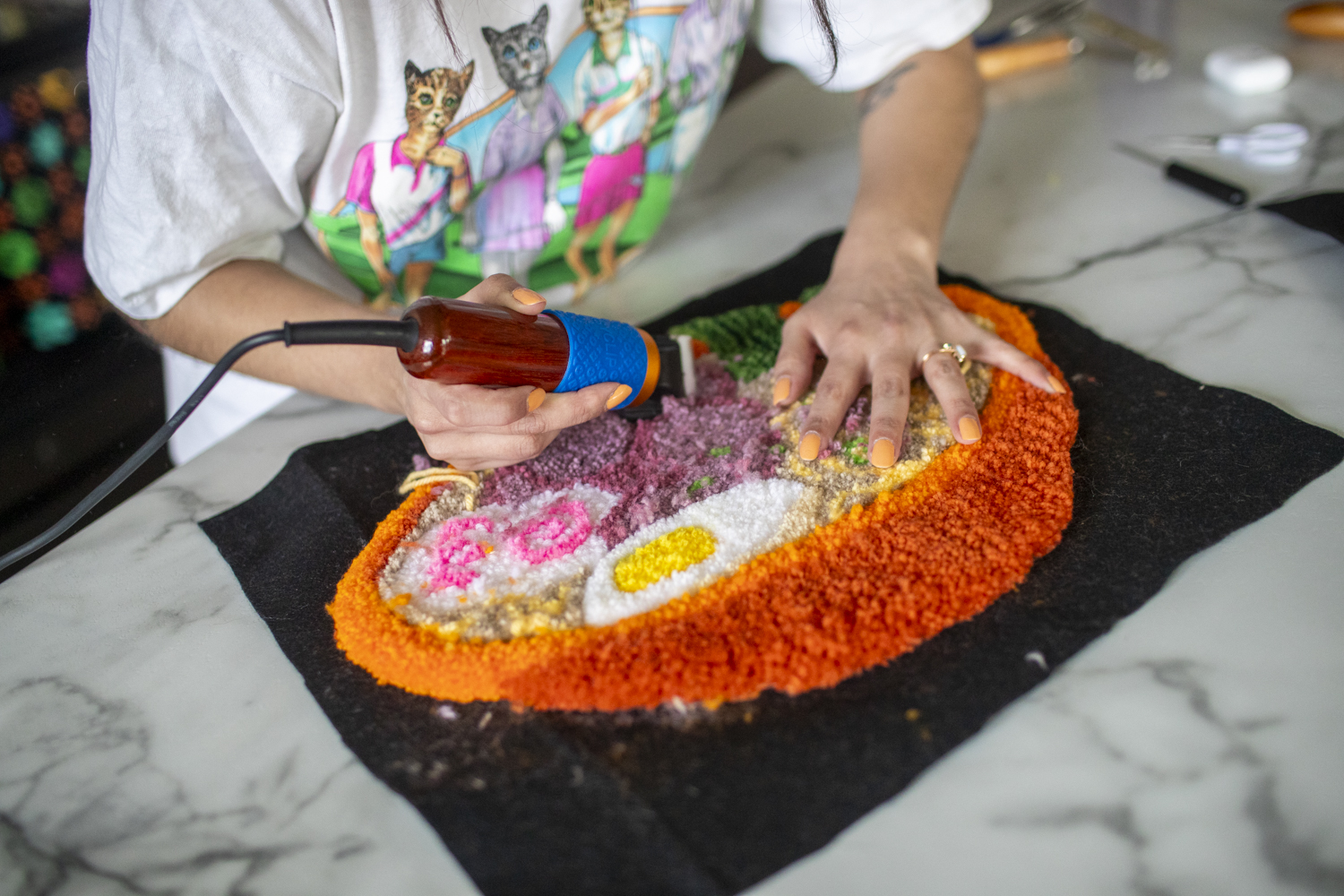A random Amazon purchase catapulted Thelma Trujillo, a University of Iowa English doctoral candidate, into the world of rug making just last year.
At her first pop-up flea market in August 2023, she sold almost all her rugs.
In need of a new hobby, Trujillo first started with punch needling, a process that creates small rug-like embroidery pieces. She purchased a punch needle kit with outlines and all the materials she would need, which was perfect to get her started, Trujillo said.
“I had a tough time with it at first,” the artist shared. “I kept poking holes through the fabric, but miraculously I tried again and practiced and have been doing fiber art for a good year.”
When Trujillo isn’t needle punching or tufting, she is a writer, educator, and researcher of topics within medieval literature history. After completing her doctoral qualifying exam, her friends gifted her a tufting gun — a tool used for larger-scale rug making.

While the results are visually similar, punch needling requires more time as the work is done manually on a smaller scale. A tufting gun makes the process easier for larger-scale work.
The process of tufting is ultimately time-consuming either way. Trujillo said it takes her about two hours on average to tuft a piece, depending on linework and the complexity of colors. It then takes another six hours for the glue to dry, and finally an additional two hours to shave the finished piece down, a step that enhances her design.
Trujillo, who suffers from rheumatoid arthritis — an autoimmune disease that affects the mobility of her joints — finds the laborious process to be particularly challenging.
“I need to recognize my limits,” she said. “If I am tufting, I can do two hours and then I have to stop.”
While the process may be slower for Trujillo than for those without her condition, typically spanning the course of several days for one project, tufting is ultimately a labor of love; she finds the end result very rewarding.
Trujillo expressed interest in the mundane everyday items we see in daily life when finding inspiration for pieces.
“I definitely love color; color is important. Most of the things I tuft are everyday things, that you don’t really look at critically,” Trujillo said. “Appreciating something as simple as an egg or sandwich is fun, especially enlarging them and making them an absurd size.”

The pieces she creates range from foods, like ramen or fried eggs, to flora and fauna, like frogs and plants. Her favorite piece she has made depicts a frog made to look like a cowboy, whom she named Freddy.
“The payoff when one piece is finished feels a lot more impactful than if I was just finishing them up in a day,” Trujillo said.
When Trujillo began tufting, she made pieces solely for friends and family — their birthdays, thank-you gifts, or just as a token of her appreciation. But after each of her friends had received their fair share of Trujillo’s rug art, she needed another outlet.
“[My friends] said, ‘You should maybe sell these,’” Trujillo recalled.
Giving more thought to the lucrative opportunity, Trujillo considered it. She said that since she liked making them and her friends enjoyed them, maybe she could share with other people as well.
She began the new venture at the first Iowa City Flea Night Market hosted in and around the James Theater in August 2023. In just that night, she sold most of her pieces.
However, during the market, fellow Iowa City artists commented on Trujillo’s price point: In comparison to other tufters, Trujillo’s pieces were relatively inexpensive.
“I decided to price things low because I was worried, they wouldn’t sell,” Trujillo said, “I wasn’t sure it would be successful, but it was.”
After receiving that feedback, mixed with the gain in confidence from the successful market, the artist reflected on the work she put into each piece and is considering changing her prices to reflect this.
“Since then, I definitely feel like my skill level has increased,” she said. “Now that I am more familiar with what fabrics work better — which yarns, adhesives — eventually I would like the price to reflect that skill and time I put into it.”
During last year’s market season, Trujillo teamed up with a friend who helped to split the booth cost. Both of them are hoping to continue to participate in the Iowa City Flea this year — the market for tuft artists is relatively untapped in Iowa City.
RELATED: Photos: Northside Night Flea Market
Feeling like a part of the Iowa City community is vital for Trujillo; in the past year, the Englert Theatre and the Iowa City Arts and Crafts Bazaar reached out to donate pieces to raise funds for the Mission Creek Festival and The Iowa City Public Library.
“I am very much open to commissions, especially local businesses, and organizations,” Trujillo said. “I want to feel part of the community.”
Not only does Trujillo want to help her local community, but with issues outside of Iowa as well.
This past January, Trujillo created watermelon punch-needle hangings and sold them at a pay-as-you-will price point. All proceeds from the watermelon pieces went toward the Palestinian Children’s Relief Fund, and Trujillo was able to donate $125.
“With the ongoing genocide, there is always this feeling of a sense of hopelessness: What can I, as an individual living in Iowa, do to advocate and speak up about this?” Trujillo said. “That is one way art can be very beneficial and reflect my politics and beliefs through this practice.”
With the Iowa City markets returning soon, Trujillo has no plans to slow down her craft.



